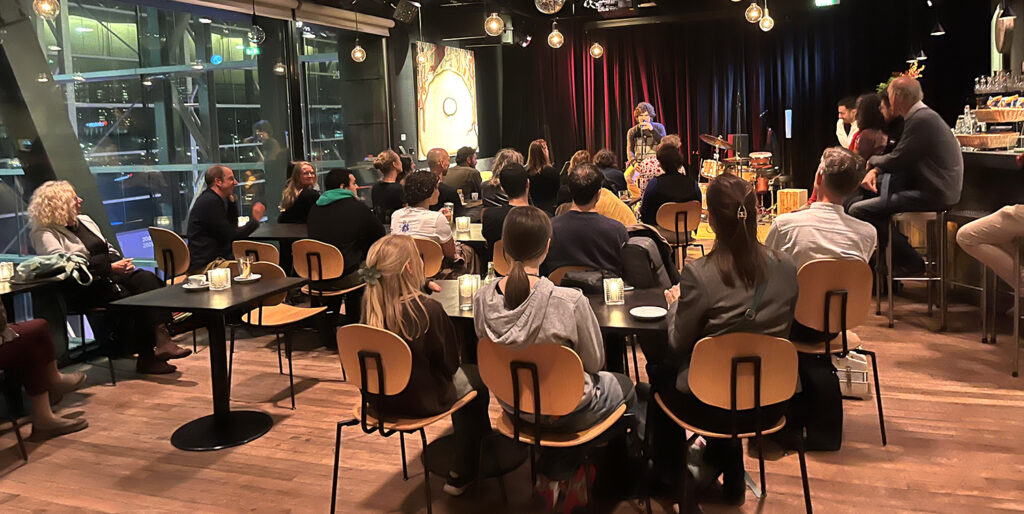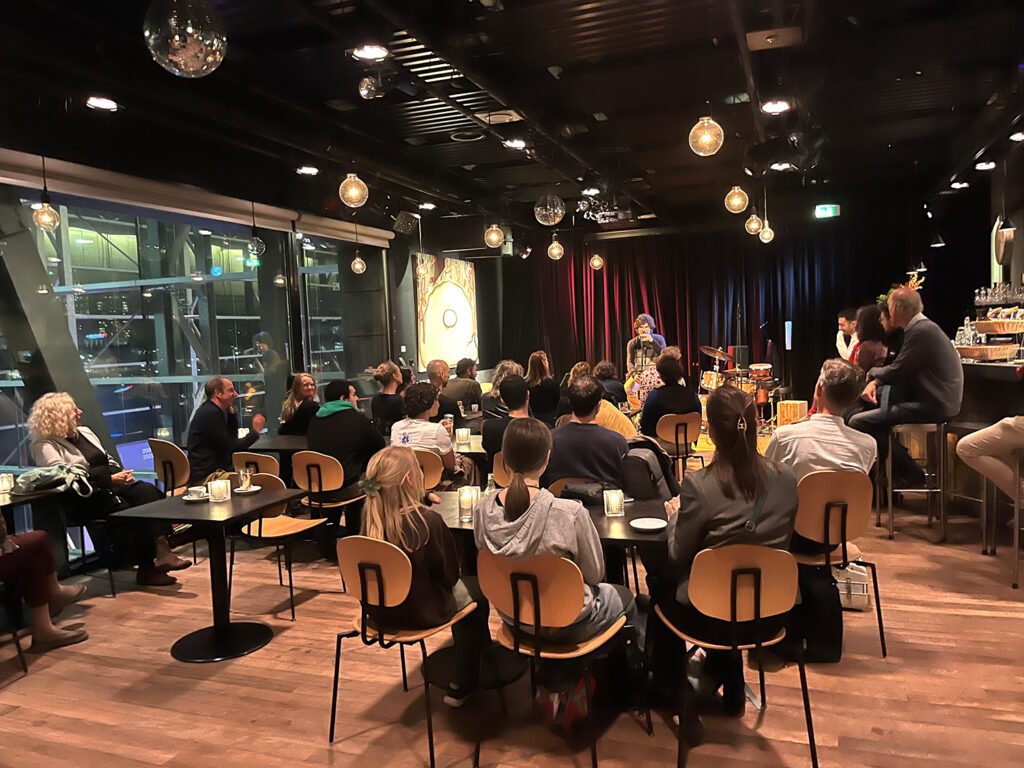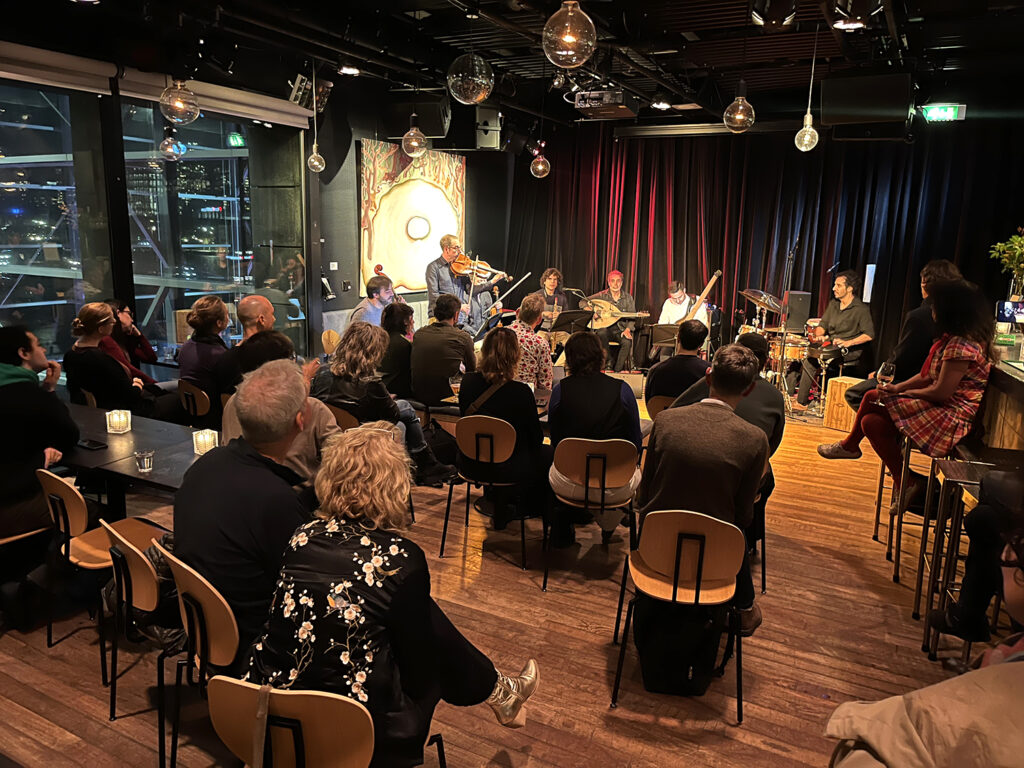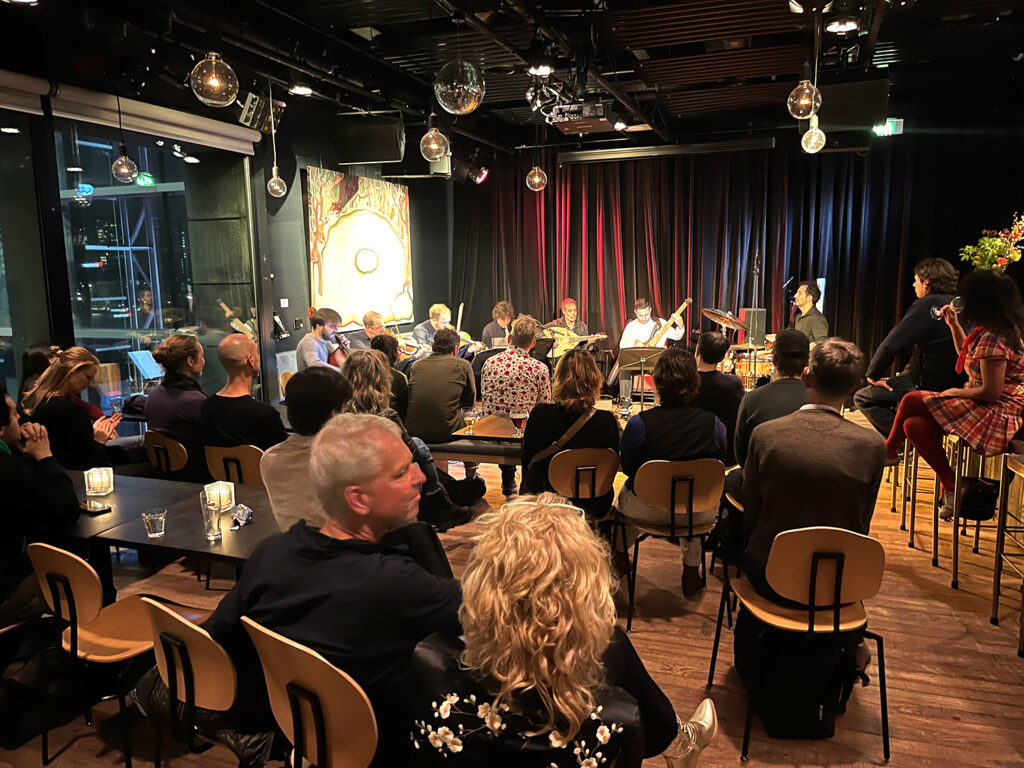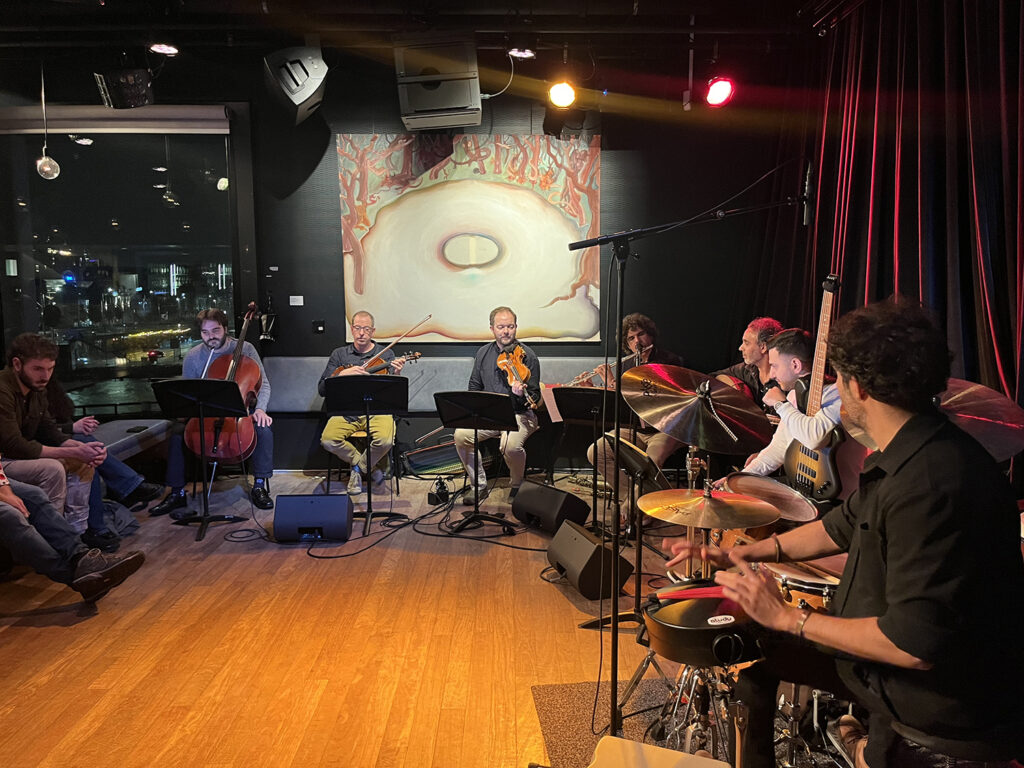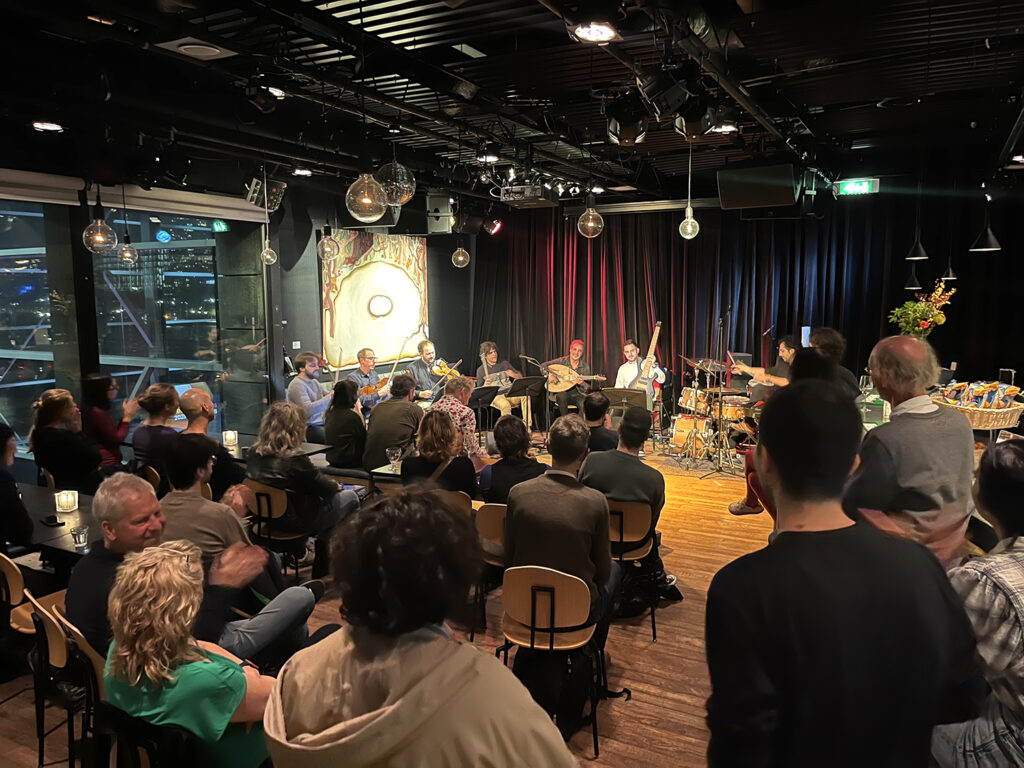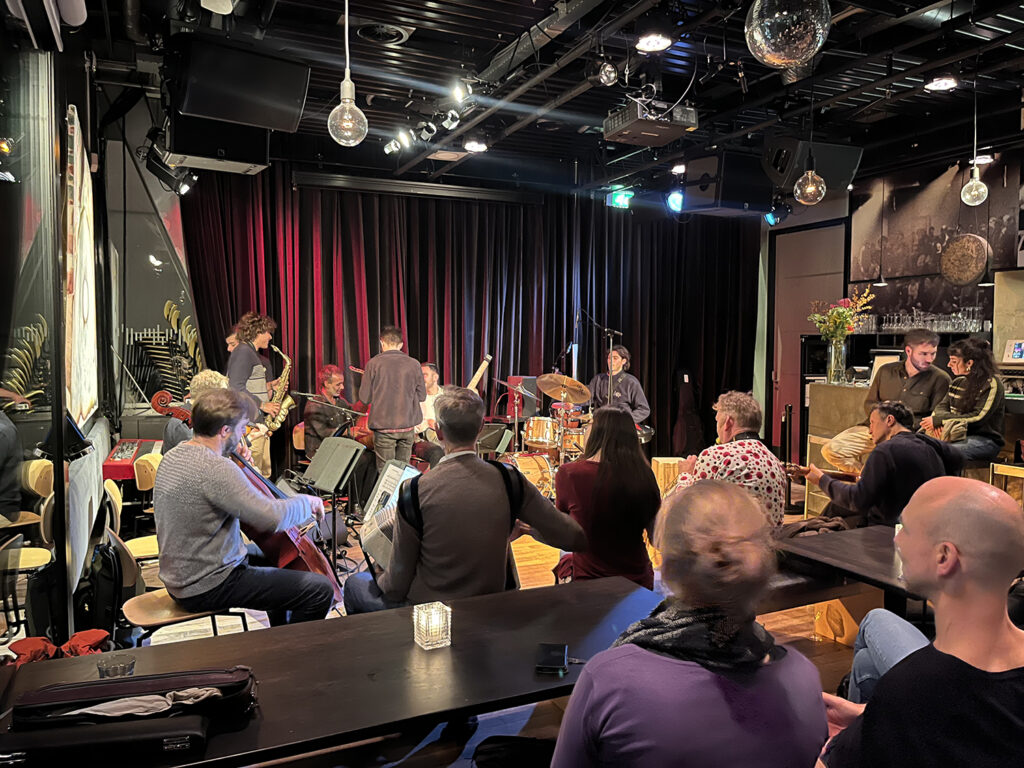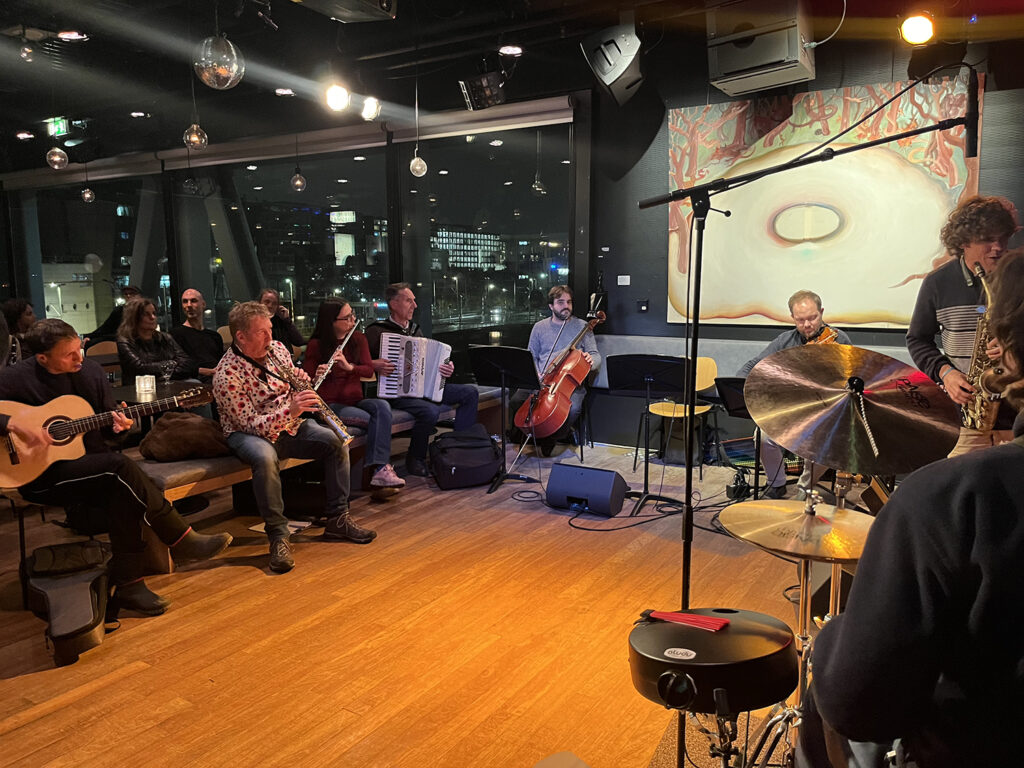Amsterdam, 20 oktober – “Als je flamenco wilt spelen,” zegt saxofonist en zanger Antonio Lizana met een glimlach, “dan moet je flamenco zijn.” In het BIMHUIS deelt de Spaanse muzikant zijn verhaal, zijn filosofie en zijn passie tijdens een inspirerende Masterclass DisOrient Fusion Lab. De avond volgt op drie uitverkochte voorstellingen van Carried by the Wind, zijn samenwerking met het Marmoucha Orchestra, in het kader van de Flamenco Biennale Nederland.
De saxofoon opent de avond
Na een korte introductie door artistiek leider van Marmoucha Orchestra, Arin Keshishi, zet Lizana de toon met een improvisatie op zijn saxofoon: een klank die direct de aandacht trekt van de deelnemers in de zaal. Bijna iedereen speelt een instrument, maar slechts een kwart is vertrouwd met flamenco. Voor velen wordt deze avond een ontdekkingsreis.
Van Al-Andalus tot Cádiz
Lizana vertelt hoe hij opgroeide in San Fernando, een klein dorpje nabij Cádiz, een regio waar de sporen van vele beschavingen nog hoorbaar zijn. “Many civilizations have concurred this part of Spain,” zegt hij. “You can see it in the architecture, the food, and also in the music.”
Van de 8e tot de 15e eeuw leefden in Al-Andalus moslims, joden, christenen, Afrikanen en Roma grotendeels in vrede samen. Na de Reconquista moesten de meeste niet-christelijke bevolkingsgroepen vertrekken. Alleen de gitano’s – de Spaanse Roma – mochten in beperkte mate blijven. Omdat zij rondtrekkend leefden, werden ze door de christelijke machthebbers niet als bedreigend of van grote invloed op de christelijk stedelijke cultuur gezien. Veel anderen verloren alles en sloten zich, in sommige gevallen, bij de gitano’s aan.
“Flamenco is in feite een mengsel van al die culturen,” legt Lizana uit, “muziek van mensen die hun thuis zijn kwijtgeraakt. Daarom klinkt flamencozang vaak als een klaagzang.”
Elke streek ontwikkelde zijn eigen stijl, maar volgens Lizana moet een echte flamenco-artiest alle stromingen kennen. Zijn leraar drukte hem echter ook op het hart nooit zijn eigen landscape te verliezen: “If you lose that, you lose your identity.”
Van klassiek naar jazz, en weer terug
Hoewel flamenco in zijn familie aanwezig was, luisterden zijn ouders liever naar rock. Op achtjarige leeftijd koos Antonio, min of meer willekeurig, de saxofoon als instrument. Hij begon met klassieke muziek, maar vanaf een jaar of 15 raakte hij door vrienden toch in de ban van flamenco. Toen hij de zang- of gitaarlijnen probeerde na te spelen met zijn saxofoon, voelde hij echter dat er iets niet klopte. “Ik dacht dat ik misschien meer over jazz moest gaan leren,” vertelt hij.
In Cádiz volgde hij vervolgens een jazzopleiding om beter te leren improviseren. Daar ontdekte hij artiesten als Charlie Parker en John Coltrane. Jazz voelde kosmopolitisch, Amerikaans, terwijl flamenco voor hem iets “uit het dorp” was. Toch keerde hij later terug naar zijn roots. Zijn afstudeercomposities, een stuk met flamenco-ritme en een met Arabische invloeden, werd onverwacht enthousiast ontvangen. “Ik dacht dat het te simpel was,” lacht hij, “maar iedereen noemde me een genie en wilde alles weten over mijn methode, terwijl ik het zelf eigenlijk beschouwde als het resultaat van mijn ‘incapacity as a composer.’” Kort daarna verscheen zijn eerste album.
“Ik wilde leren zingen met mijn saxofoon”
Na zijn studie kozen veel klasgenoten voor een master in Amsterdam, maar Lizana keerde terug naar Andalusië. Daar begon hij te zingen, uit noodzaak, omdat er geen zangers waren, en vond hij een nieuwe manier van spelen. “Mijn tante zei: doe wat soleá-achtigs, voel de diepte van iedere noot.”
Dat werd een keerpunt. “Ik realiseerde me dat mijn saxofoon moest klinken alsof ik zong. De ziel had ik niet geleerd op school.” Voor Lizana is ritme de ware universele taal. “Mensen zeggen dat muziek universeel is, maar ik denk dat ritme dat is,” zegt hij. “Zoals voedsel: het duurt even voordat een nieuw dieet een natuurlijk aanvoelt voor je lichaam.”
Met zijn telefoon laat hij een metronoom horen door de microfoon, speelt er losjes omheen en grijnst: “If you can play the uptempos outside the click, you are there.”
Muziek als dialoog
Tijdens de masterclass benadrukt hij dat muziek een gesprek is tussen musici. “Als ik speel en niemand voelt de behoefte om mee te doen, dan doe ik iets verkeerd,” zegt hij, waarna hij demonstreert hoe hij “groove” opwekt met zijn saxofoon. Hij illustreert ook dat er in flamenco geen vaste zangtechniek bestaat: het draait om authenticiteit. “Je moet je eigen limiet kennen en daar optimaal van profiteren.”
Reflectie en inspiratie
De anderhalf uur van de masterclass vormen een mini-college over de geschiedenis en ziel van flamenco. Daarna volgt een kort concert met het Marmoucha Orchestra, waarin vier nummers uit Carried by the Wind worden gespeeld, een betoverende afsluiting van de theoretische verdieping.
Om 22:15 barst de zaal los: gitaren, klarinetten, dwarsfluiten en accordeons verschijnen, en het podium verandert in een bonte jam van muziekenthousiastelingen die nog drie kwartier samen spelen.
Publieksreacties
De deelnemers reageren na afloop met zichtbaar enthousiasme. Een accordionist vat het mooi samen:
“Het was heel grappig hoe Antonio de koudbloedige jazzvirtuoos uitbeeldde, zó herkenbaar. En zijn uitleg over comping, het begeleiden van een melodie, raakte me. Hij liet zien dat samenspelen de basis is van alles: als je luistert naar elkaar, ontstaat echte muziek en wordt muziek een communicatiemiddel.Ik vond het ook een bijzonder inzicht, dat als je een stijl wilt leren, je er iets in moet componeren. Dat dwingt je om er echt in te duiken en het te begrijpen.”
Een ervaren flamencodanseres vertelt dat ze geraakt is door de historische uitleg:
“Ik voelde veel herkenning, maar er waren ook dingen die ik nog niet wist, vooral over de oorsprong van de stijl. Het was ontzettend leerzaam om dit te horen van iemand die flamenco zó diep begrijpt. Zijn manier van vertellen maakte de geschiedenis levend.”
Een Amerikaanse accordeonist vond de avond inspirerend op persoonlijk vlak:
“Ik speel accordeon in een polkaband, maar deze masterclass heeft me echt aangemoedigd om mijn eigen pad te volgen. Antonio liet zien dat je geen ‘achtergrondmuzikant’ hoeft te blijven, je kunt altijd iets nieuws creëren.”
Tot slot klinken er veel lovende woorden voor het Marmoucha Orchestra:
“Ik heb de voorstelling vorige week gezien, en ook eerdere projecten van Marmoucha Orchestra. Ze hebben de gave om met gastmuzikanten samen te werken zonder schade te berokkenen aan diens identiteit. Ze versterken hun gastmuzikanten en zorgen dat ze het beste in elkaar naar boven halen. Ik ben absoluut fan, en ook een echte ambassadeur geworden,” glimlacht een bezoeker.
De avond eindigt met een gevoel van warmte, verbondenheid en gedeelde inspiratie, precies waar flamenco om draait.
Masterclass at BIMHUIS: Antonio Lizana on the Soul of Flamenco
Amsterdam, 20 October – “If you want to play flamenco,” says saxophonist and singer Antonio Lizana with a smile, “then you have to be flamenco.” At the BIMHUIS, the Spanish musician shares his story, his philosophy, and his passion during an inspiring Masterclass DisOrient Fusion Lab. The evening follows three sold-out performances of Carried by the Wind, his collaboration with the Marmoucha Orchestra, as part of the Flamenco Biennale Nederland. The saxophone opens the night
After a brief introduction by Marmoucha Orchestra’s artistic director, Arin Keshishi, Lizana sets the tone with an improvisation on his saxophone, a sound that instantly captures the audience’s attention. Almost everyone in the room plays an instrument, but only a quarter says to be familiar with flamenco. For many, this evening becomes a true voyage of discovery.
From Al-Andalus to Cádiz
Lizana recounts how he grew up in San Fernando, a small town near Cádiz, a region where traces of many civilizations can still be heard. “Many civilizations have conquered this part of Spain,” he says. “You can see it in the architecture, the food, and also in the music.”
From the 8th to the 15th century, Muslims, Jews, Christians, Africans, and Roma lived together in relative peace in Al-Andalus. After the Reconquista, most non-Christian populations were expelled. Only the gitanos, the Spanish Roma, were allowed to remain to a limited extent. Because they lived a nomadic life, Christian rulers did not see them as a threat or as a major influence on urban Christian culture. Many others who lost everything joined them in this life.
“Flamenco is really a blend of all those cultures,” Lizana explains, “music made by people who were displaced from their homelands. That’s why flamenco singing often sounds like lamentation.”
Each region developed its own style, but according to Lizana, a true flamenco artist must understand them all. His teacher, however, also urged him never to lose his own landscape: “If you lose that, you lose your identity.”
From classical to jazz, and back again
Although flamenco was present in his family, his parents preferred rock music. At the age of eight, Antonio chose the saxophone, more or less by chance, as his instrument. He began with classical training, but around the age of fifteen, friends drew him into the world of flamenco. When he tried to imitate the vocal or guitar lines on his saxophone, something felt off. “I thought maybe I needed to learn more about jazz,” he says.
In Cádiz he enrolled in a jazz program to improve his improvisation skills. There he discovered Charlie Parker and John Coltrane. Jazz felt cosmopolitan, American, while flamenco to him was “something from the village.” Yet he eventually returned to his roots. His graduation compositions, one based on flamenco rhythms and another with Arabic influences, were met with unexpected enthusiasm. “I thought it was too simple,” he laughs, “but everyone called me a genius and wanted to know all about my method, while I saw it as the result of my incapacity as a composer.” Shortly after, his first album was released.
“I wanted to learn to sing with my saxophone”
After graduating, many classmates went on to do a master’s in Amsterdam, but Lizana returned to Andalusia. There, out of necessity, because no singers were around, he began to sing, and in doing so discovered a new way of playing. “My aunt told me: do something soleá-like, feel the depth of every note.”
That became a turning point. “I realized my saxophone had to sound as if I were singing. The soul, that’s what I hadn’t learned at school.” For Lizana, rhythm is the true universal language. “People say music is universal, but I think rhythm is,” he says. “It’s like food: it takes time before a new diet feels natural to your body.”
He demonstrates by playing a metronome sound through the microphone from his phone, then plays freely around the beat, grinning: “If you can play the uptempos outside the click, you are there.”
Music as dialogue
Throughout the masterclass, Lizana emphasizes that music is a conversation between musicians. “If I play and no one feels the urge to join in, then I’m doing something wrong,” he says, before demonstrating how he creates “groove” on his saxophone. He also shows that flamenco has no fixed singing technique: it’s all about authenticity. “You have to know your own limits and make the most of them.”
Reflection and inspiration
The ninety-minute masterclass unfolds like a crash course on the history and soul of flamenco. It is followed by a 30-minute concert with the Marmoucha Orchestra, featuring four pieces from Carried by the Wind, a spellbinding finale to an evening rich in depth and connection.
At 22:15, the venue erupts: guitars, clarinets, flutes, and accordions appear, and the stage transforms into a joyful jam session that continues for another forty-five minutes.
Audience reactions
Participants respond with visible excitement. One accordionist sums it up beautifully:
“It was hilarious how Antonio imitated the cool-blooded jazz virtuoso, it felt so recognizable to me! His explanation of comping, accompanying a melody, really struck me. He showed that playing together is the foundation of everything: when you truly listen to each other, music becomes a language of communication. And his advice to compose something in a style you want to learn, that was such a powerful insight.”
An experienced flamenco dancer shares how moved she was by his historical perspective:
“So much felt familiar, yet there was a lot I didn’t know, especially about the origins of the style. It was wonderful to learn this from someone who understands flamenco so deeply. His storytelling brought history to life.”
An American accordionist found the evening personally inspiring:
“I play accordion in a polka band, but this masterclass really encouraged me to carve my own path. Antonio showed that you don’t have to remain a background musician, you can always create something new.”
Finally, there is unanimous praise for the Marmoucha Orchestra:
“I saw the performance last week, as well as earlier Marmoucha projects. They have a gift for collaborating with guest musicians without compromising anyone’s identity. They truly bring out the best in each other. I’m absolutely a fan, even an ambassador,” one participant smiles.
The evening ends in an atmosphere of warmth, connection, and shared inspiration, exactly what flamenco is all about.

